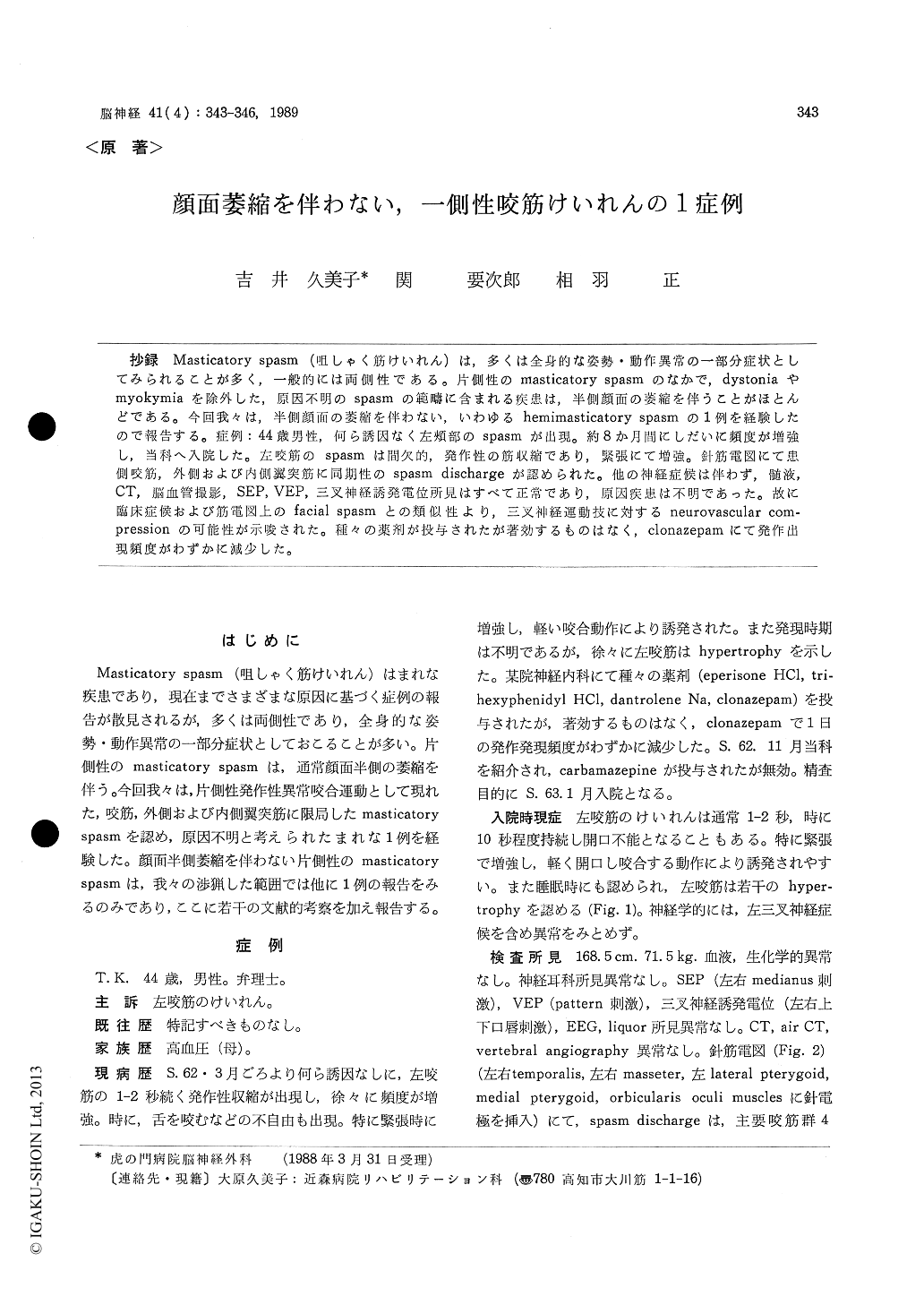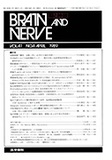Japanese
English
- 有料閲覧
- Abstract 文献概要
- 1ページ目 Look Inside
抄録 Masticatory spasm (咀しゃく筋けいれん)は,多くは全身的な姿勢・動作異常の一部分症状としてみられることが多く,一般的には両側性である。片側性のmasticatory spasmのなかで,dystoniaやmyokymiaを除外した,原因不明のspasmの範疇に含まれる疾患は,半側顔面の萎縮を伴うことがほとんどである。今回我々は,半側顔面の萎縮を伴わない,いわゆるhemimasticatory spasmの1例を経験したので報告する。症例:44歳男性,何ら誘因なく左頬部のspasmが出現。約8か月間にしだいに頻度が増強し,当科へ入院した。左咬筋のspasmは間欠的,発作性の筋収縮であり,緊張にて増強。針筋電図にて患側咬筋,外側および内側翼突筋に同期性のspasm dischargeが認められた。他の神経症候は伴わず,髄液,CT,脳血管撮影,SEP,VEP,三叉神経誘発電位所見はすべて正常であり,原因疾患は不明であった。故に臨床症候および筋電図上のfacial spasmとの類似性より,三叉神経運動技に対するneurovascular com-pressionの可能性が示唆された。種々の薬剤が投与されたが著効するものはなく,clonazepamにて発作出現頻度がわずかに減少した。
Masticatory spasm is a rare clinical feature and mostly associated with disorders of general move-ment. Usually it occurs bilaterally. Unilateral masticatory spasm is mostly associated with facial hemiatrophy.
So, unilateral masticatory spasm without facial hemiatrophy is extremely rare.
As far as we have investigated, only one case has been reported in the literature.
We will report one more case herein, with some discussion on its pathogenesis.
Case report
A 44-year-old man presented with a 8 month history of slowly progressive recurrent spasm of the left masseter muscle. The spasm was exag-gerated by tension and lasted for up to 10 seconds. Several drugs could not reduce the frequency of spasm, but only clonazepam could decrease it slightly.
On admission, the spasm lasted usually for 1 or 2 seconds.
Except for masticatory spasm, neurological exa-mination comprising trigeminal nerve function, was normal and facial atrophy was not observed. On the contrary, hypertrophy of the left massetermuscle was noted.
Needle electromyography (EMG) study revealed synchronized spasm discharges of the ipsilateral masseter, lateral and medial pterygoid muscles. All of other investigations, including CSF analysis, electroencephalography, somatosensory evoked potential, visual evoked potential, CT scan and vertebral angiography, showed normal findings. After all, we could not find any apparent organ-ic lesions which cause masticatory spasm, so surgi-cal treatments were not carried out.
He was discharged and now, continues to take clonazepam daily.
In a discussion of the abnormal unilateral invol-untary movement of the jaw and face, Thompson discribed 9 causes :① local mechanical disorders of the mandible or temporo-mandibular joint, ② tetanus and trismus, ③ focal motor epilepsy, ④ unilateral dystonia of the jaw, ⑤ tonic spasm of multiple sclerosis, ⑥ hemimasticatory spasm, with or without facial hemiatrophy, ⑦ tetany, ⑧ hemi-facial spasm (face only), ⑨ facial myokymia (faceonly).
We think that this case falls under the catego-ry of hemimasticatory spasm without facial hemi-atrophy and only another one case has been re-ported in the literature.
An apparent organic lesion causing masticatory spasm was not found and surgical treament was not performed in this case. But we supposed that his clinical features and EMG findings were very similar to those described in hemifacial spasm.
Therefore, we supposed that neurovascular com-pression to the trigeminal nerve fiber might be the cause of this masticatory spasm, as well as neuro-vascular compression to the facial nerve fiber could be the cause of hemifacial spasm.
However, no operation has been carried out with hemimasticatory spasm without facial hemiatrophy before.
We guess that neurovascular decompression technique would be undertaken to this disease in the future.

Copyright © 1989, Igaku-Shoin Ltd. All rights reserved.


